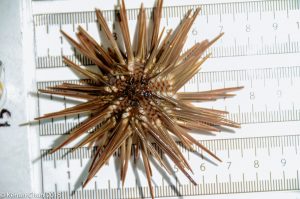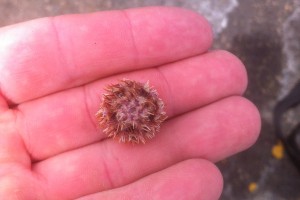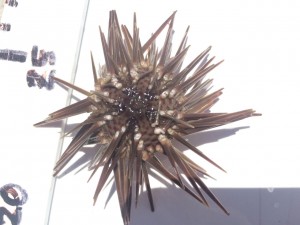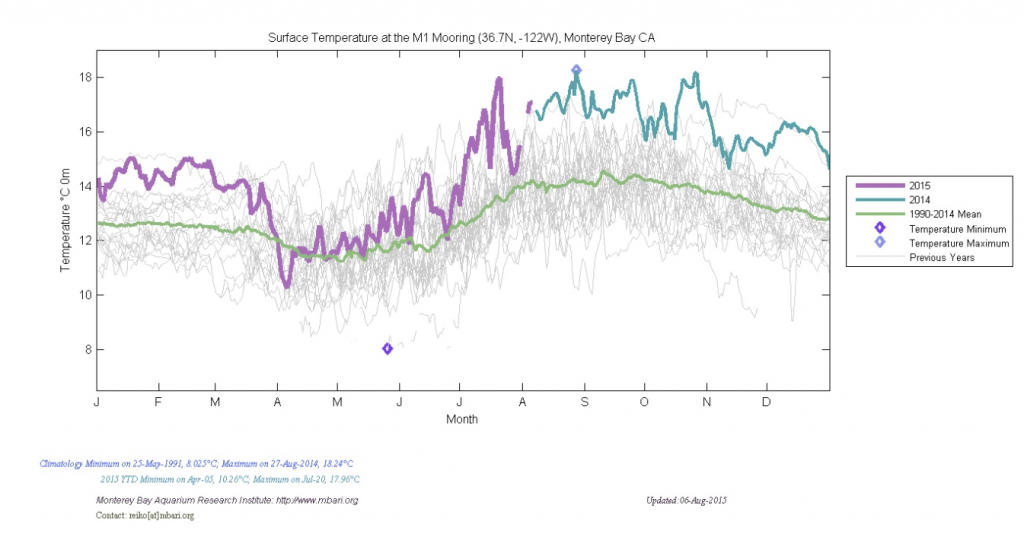
In July and early August 2015 two species of sea urchins have been observed that rarely–if ever–are seen in the kelp forests of Monterey Bay National Marine Sanctuary. Within a span of three weeks, researchers found two white urchins (Lytechinus pictus) and a black sea urchin (Arbacia stellata) in the kelp beds along Cannery Row.
Historic range records indicate that white urchins Lytechinus pictus (also called L. anamesus) have been found as far north as Monterey Bay at depths below 20 m, but the species is much more common in southern California and Mexico. White urchins have not been observed in central California kelp forests since at least the early 1990s. The black urchin Arbacia stellata occurs in intertidal habitats to depths of 90 m in the Gulf of California, and as far south as Peru and the Galapagos Islands. Prior to the 1997-98 El Nino, the lone California range record was from Newport Bay in southern CA, where 6 black urchins were found during the Velero III cruises between 1931-1941 (as reported in Clark 1948). However, during the warm-water ENSO event of 97-98, several dozen Arbacia stellata were found in the rocky intertidal and subtidal of 5 of the Channel Islands off the coast of southern California (Engle and Richards 2001). Arbacia stellata (also called A. incisa and Echinocidaris incisa) is very common in the Gulf of California, but has never been observed in central California.

On July 14, 2015 Colin Gaylord, a research diver for UC Santa Cruz’s Partnership for Interdisciplinary Studies of Coastal Oceans (PISCO) was conducting annual subtidal surveys in nearshore kelp forests as part of a long-term, large-scale monitoring program along the west coast of the California. While diving at the Cannery Row study site, he noticed what some divers might mistake as a juvenile purple urchin (Strongylocentrotus purpuratus) but noted this urchin had some striking differences. Juvenile purple urchins are actually a very pale green color, and as the urchin grows the spines turn purple. The urchin Colin found was white and had dark purple patches on the aboral surface. It turned out to be Lytechinus pictus, a warm-water species common in southern CA but very rare in central California. Colin observed a second white urchin on August 4, 2015 at the McAbee study site, about 600 m down the coast from the first site.

PISCO research diver Kenan Chan was diving with Colin at the McAbee study site on August 4, 2015 and observed a different urchin, even more conspicuous than the white urchin. While searching the exposed surface of the rocky reef, Kenan saw a black urchin Arbacia stellata. This species does not look like any of the native urchins, and is remarkable due to obvious red splotches along the aboral interambulacra, which is also conspicuously devoid of spines. This extralimital range record, when confirmed by taxonomists at the California Academy of Sciences, extends the known northern occurrence of this species by 225 miles.
Both of the urchins were large enough to have recruited into Monterey Bay at least one year ago, if not longer. 2014 was an especially warm year for the surface waters of Monterey Bay, about 2 degrees C above the 25-year average. When conditions are suitable and coastal currents transport larvae northward from southern CA and beyond, seeing warm-temperate and subtropical species is not uncommon. In June 2015 Dr. Steve Lonhart, Senior Scientist for MBNMS, saw a young-of-the-year (YOY) sheephead wrasse (Semicossyphus pulcher) and multiple divers reported sightings of YOY kelp bass (Paralabrax clathratus) at the Breakwater in Monterey.
2015 is shaping up to be another warm year, and it remains to be seen whether even more species from the south will appear in the near future.
To read a related article in the Santa Cruz Sentinel newspaper, click here.
